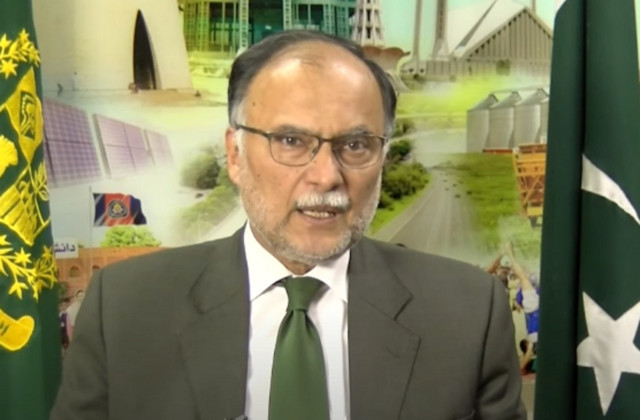Islamabad:
The last agriculture census has revealed that 97% of Pakistan farmers have less than 12.5 acres of land and the size of a farm has also been reduced, that the Minister for Planning of Ahsan IQBAL says it is a concern due to the reduction of the economy of the economy.
There were only 16,958 owners in Pakistan who owned more than 100 acres of land and had 6.2% of the total agricultural lands, according to the seventh census that the Pakistan statistics office completed after a 15 -year -old gap. The average property of these owners was 215 acres per person.
The seventh national census of agriculture and cattle has given some rare ideas about the mostly informal sector of the economy, particularly the trends on the use of water, crop cultivation, land holdings and the penetration of livestock in several provinces.
Iqbal officially launched the results of the seventh 2024 agricultural census that, he said, was a milestone in the statistical history of Pakistan that covers agriculture, livestock and agricultural machinery in a report.
The details showed that 97% of the country’s total agricultural community has less than 12.5 acres of land and suggests that they fall into the low media income groups. Such small land owners do not generate enough resources to save money and these poor farmers live crops to cut.
In 2010, 89% of farmers had less than 12.5 land acres. An important reason was the division of hereditary lands and the sale of the properties to cover some important expenses, according to people who have made the census.
There were 26% farmers who had even less than an acre land, a proportion that was only 15% in 2010. About 35% of the total farmers had less than 2.5 acres of land. In the nutshell, 61% of farmers have less than 2.5 acres of land, which is not enough to guarantee decent profits for these poor people due to outdated agricultural techniques and low yields.
About 19% of farmers had less than five acres of land, which is also too small to generate enough resources for people who live mainly in villages with fewer facilities. Another tenth of the farmers had less than 7.5 acres of land and there was hardly 7% of farmers who really had 12.5 acres of land.
The average size of the farm has been reduced from 6.4 to only 5.1 acres, which is worrying, said Ahsan Iqbal while talking at the launch ceremony. The planning minister said that such small sizes reduce the scale of the economy and minimize the perspectives of corporate agriculture.
But he said that, in general, the results of the census were encouraging and would also contribute positively to the country’s gross domestic product due to the possibility of measuring the results instead of relying on obsolete surveys.
Iqbal said that census findings would help plan a better planning to lift small farmers in the country.
According to the census, there was a significant increase in the cultivated area, which increased to 52.8 million compared to 42.6 million at the time of the last census.
In general, agriculture remains a key sector of Pakistan’s economy, contributing significantly to GDP. Approximately the sustenance of 40 million people is directly related to agriculture and 37.4% of the workforce used by the sector.
The census showed that there were about 20 million agricultural homes, and 98.5% were male bosses.
The survey stated that in 2024, Pakistan had around 11.7 million total farms, significantly exceeding 8.3 million in 2010. Most of the farms were operated by owners, approximately 10.4 million, compared to 6.74 million in 2010, indicating a strong change towards the property of the farm.
The owner-cum-inquiline farms decreased to only 550,000 and the farms only for tenants also fell significantly to 770,000, which shows a strong reduction in agriculture based on lease.
In all provinces, Punjab had the largest number of farms at 5.1 million, but these were 217,000 less than 15 years ago. A possible reason for the reduction of the number of farms in Punjab was the rapid urbanization in the province, said Ahsan Iqbal.
The growth of housing societies can be seen in Punjab and many of them are not properly planned or approved by land authorities.
The KP has 4.2 million farms, Sindh 1.8 million and Baluchistan 630,000 with most in each province that owns operated farms. Even in Islamabad, almost all 16,589 farms were owned.
Together with an increase in the total number of farms, the total area of the farm also increased, increasing from approximately 52.9 million acres in 2010 to 59.3 million acres in 2024.
Similarly, the total cultivated area has increased from around 42.6 million acres in 2010 to 52.8 million acres in 2024. On average, each farm in 2024 had approximately 5.1 acres of size, below 6.4 acres in 2010. The average cultivated land per farm also decreased from 5.2 acres in 2010 to 4.5 acres in 2024, which reflects the same trend of the great farm.
In 2024, the total irrigation area of Pakistan is 45.9 million acres of the total, 14.4 million acres were watered by the channels, compared to 12.3 million acres in 2010, according to the census.
A slight decrease in combined irrigation methods was observed, such as channels, tube wells, pumps, which were reduced to 13.5 million acres in 2024. Punjab has the largest irrigation area with 27.1 million acres in total, followed by Sindh with 7.3 million acres. Although in the areas of KP and Baluchistan are irrigated by the channel, other sources are also used. Interestingly, traditional methods such as Rod Kohi and Karez continue to work in Baluchistan, according to the census.
Non -irrigated agriculture (fed with rain) saw a strong decrease to 4.9 million acres in 2024, of 8.4 million in 2010, reflecting a change towards irrigated agriculture throughout the country.
Trimmed area
The total area of Pakistan increased significantly from 68 million acres in 2010 to 82.8 million acres in Census 2024, showing growing confidence in the agricultural sector. The cut area is more than 52.8 million total cultivated land because a piece of land can be used several times in a year depending on the culture cycle.
Among all the main crops, the proportion of the trimmed area of wheat continued to be the dominant participation in crops in the country, and its contribution increased slightly from 42% to 43.3% in the general Pakistan. The rice culture area has seen a slight decrease from 14% to 12.9%, while corn increased from 4% to 5.1%.
The cotton action fell abruptly from 14% to 7.9%. Participation in sugarcane in cut areas has also decreased from 4% to 3.3%. Forage cultivation participation increased slightly 9% to 9.5%.
The main PBS Statistical Dr. Naeem Uz Zafar explained that the cattle has the highest participation of 63.6% in the total agricultural sector, followed by 32.6% of the participation of the crops.
Cattle
In 2024, the population of general cattle of Pakistan reached 251.3 million, which was significantly higher than the last 2006 census. The main statistic said that the cattle sector showed an annual growth rate of 3.1% in 2024.
Punjab has the greatest participation with 104 million animals, leading in cattle, buffalo, horses and donuts in Pakistan. The province of Baluchistan has 47.9 million total animals of those 18.8 million were sheep, which is in line with the harsh conditions such as water scarcity.
Khyber-Pakhtunkhwa reported a total of 48.7 million population of animals with 22.5 million larger numbers of goats.




